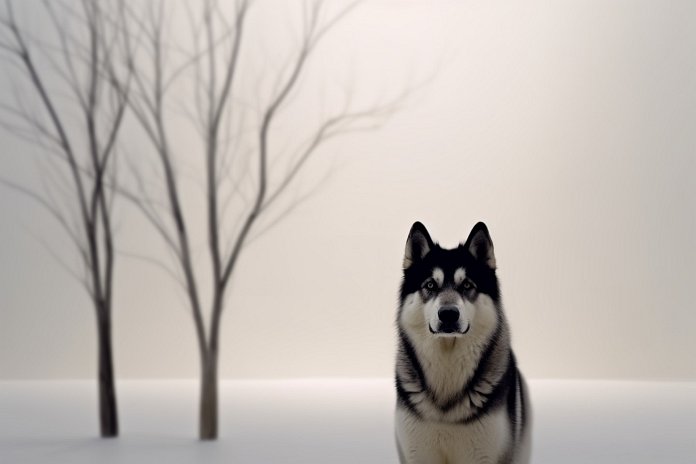
Alaskan Shepherds are loyal and courageous companions, much like their predecessors, the large working dogs. They are highly intelligent and require regular exercise, mental stimulation, and grooming to stay happy and healthy. While they require firm training from a young age, Alaskan Shepherds can be wonderful pets for families willing to invest the necessary effort.
This breed likely originated in the early 1900s, when the German Shepherd and Alaskan Malamute were both popular in the United States. However, Alaskan Shepherds are not recognized as a purebred breed by the American Kennel Club and are considered rare hybrids.
Below, we look at Alaskan Shepherd dog breed, its history, personality, pros and cons of owning an Alaskan Shepherd, characteristics, and must-see facts. We will also examine how to care for this breed and more. Prepare for a tail-wagging adventure into the world of Alaskan Shepherds!
| Dog Breed | Alaskan Shepherd |
| Size | Large |
| Weight | 60-75 lbs (average) |
| Height | 22-24″ (average) |
| Location | Unknown |
| Ancestry | Alaskan Malamute, German Shepherd |
| Date of Origin | Early 1900s |
| Group | Companion, Hunting, Guarding |
| Life Expectancy | 11-15 years |
| Price | $800 – $2000 |
| Family | Canidae |
| Scientific Name | Canis Lupus Familiaris |
📖 Breed History
The Alaskan Shepherd is a mix of two dog breeds: the Alaskan Malamute and the German Shepherd. The Alaskan Malamute is an ancient breed that originated from wolf dogs over 4,000 years ago. It was named after the Mahlemuts Innuit tribe in Alaska, where it was first bred for hunting and sled pulling. In the 1800s, Alaskan Malamutes were imported to the United States for Gold Rush expeditions and were later bred with smaller dogs for racing and entertainment purposes. However, efforts were made in the 1920s to revive the purebred Alaskan Malamute, and it is now the official state dog of Alaska and recognized by the AKC.
On the other hand, the German Shepherd originated in Germany as a herding dog in the 1800s. It was initially called the German Sheepdog and was known for its good behavior and responsiveness. It was later used as a working dog in the German military during World War I. The breed gained popularity in Europe and North America, and it was officially recognized by the American Kennel Club in 1908. The German Shepherd remains a popular breed in the United States and Europe, especially in Germany.
The combination of the Alaskan Malamute and German Shepherd has resulted in the Alaskan Shepherd, a large, alert, and affectionate pet. This hybrid breed may have been around since the early 1900s, considering the long history of both parent breeds in the United States. However, it is not recognized by the AKC and is relatively rare.

🐕 Alaskan Shepherd Appearance
There are significant physical similarities between the German Shepherd and the Alaskan Malamute. The Alaskan Shepherd has many characteristics with both parent breeds as a consequence; it is longer than it is tall, has upright and pointed ears, almond-shaped eyes, a dark nose, and is built with muscles. Additionally, it has a rather long, plumed tail and broad, arched paws that are well-padded. The Alaskan Shepherd often has black markings on the nose and forehead and can also appear in a range of colors that are common to its parent breeds. The breed has a thick coat. It is medium in length, thick, and straight.
| 👀 Eye Color | Blue |
| 🐽 Nose Color | Black, Brown |
| 🐕 Coat Color | Gray, Red, Cream, Brown, Black, White, Sable, Silver, Blue |
⚡ Fun Fact: Alaskan Shepherd dogs are a social breed. They enjoy being around people or other animals. This breed doesn’t tolerate being left alone.
🐶 Traits & Temperament of Alaskan Shepherd
Alaskan Shepherds are renowned for being brave, devoted, and independent—but occasionally distant—individuals. They need strict and enduring training; else, this independent breed would mistreat its owners. Early socialization is crucial for rearing an adjusted puppy because Alaskan Shepherds have a history of biting unfamiliar canines and people. In addition to this, Alaskan Shepherds are very clever and can be trained to obey a variety of directions and carry out quite difficult tasks. Remember that due to their high intelligence, Alaskan Shepherds may develop destructive tendencies if they grow bored or restless. Because of this, this breed thrives when it receives a proper balance of mental and physical activity. Additionally, Alaskan Shepherds are particularly loving with their owners and have a tendency to bond with the “pack leader” in the household. They may make wonderful pets for the appropriate kind of household since they also react quickly to praise.
🤝 Are Alaskan Shepherds Friendly or Aggressive?
Alaskan Shepherd dogs tend to not get along with other pets, but they are generally friendly towards strangers and children. They enjoy being in the company of kids and are considered dog-friendly. However, they may not be the most cat-friendly dogs. If you are looking to have multiple dogs or participate in dog meetups, the Alaskan Shepherd can be a good option. Additionally, they are often recommended as a suitable breed for elderly individuals.
This breed is known for being:
- Curious
- Playful
- Dignified
- Alert
- Courageous
- Intelligent
- Confident
- Friendly
- Affectionate
- Obedient
- Loyal
- Devoted
- Watchful
🐩 Alaskan Shepherd Care & Maintenance
Since this breed is not hypoallergenic, pet owners who suffer from allergies should avoid it. The medium-length, exceptionally dense double coats of Alaskan Shepherds shed a lot, especially as the seasons change. Weekly pin or slicker brushing and use of a deshedder helps lessen seasonal shedding and keep the coat looking tidy. However, owners might wish to brush their pets every day during shedding seasons. Only sometimes should Alaskan Shepherds be bathed, but owners should periodically examine their tails and fur for dirt. Additionally, this breed has to have their teeth washed daily and have their nails cut once or twice a month. It’s crucial to have your Alaskan Shepherd insured as soon as “pawssible” to avoid paying a lot for medical treatment. Compare insurance packages from reputable companies like Healthy Paws and Embrace to start saving over $270 annually. Want to know more about pet health insurance? Visit our pet insurance 101 guide.
Alaskan Shepherd dogs are prone to shedding a lot of hair, which is a normal part of their hair growth cycle. This means you can expect to do daily vacuum cleaning to keep up with the amount of hair they shed. The quantity and frequency of hair loss will vary based on their overall health and the specific breed they belong to. Additionally, it is recommended to give them a bath every 6 to 8 weeks to maintain their hygiene and cleanliness.
🍖 Food: We recommend 2.5 cups daily, costing you about $1.50 – $1.90 daily, or around $39.00 – $52.00 a month.
🐾 Exercise: Alaskan Shepherd dogs need quite a lot of exercise. Daily walks should be on schedule. If you live an active life, this breed can be a good choice for you.
This dog breed requires to be walked for roughly 12 miles per week, which equates to about 60 minutes of physical activity daily. This consistent moderate exercise regimen will help maintain their physical wellness and significantly contribute to their mental stimulation. Consciously setting aside this time for your furry friend can dramatically enhance their life quality, helping them stay energetic, healthy, and mentally alert.
Did you know: Alaskan Shepherd dogs are high-energy dogs. An active lifestyle makes them happy.
❤️🩹 Alaskan Shepherd Health & Issues
Some of the major concerns for Alaskan Shepherd Dog Breed can be:
- Canine Hip Dysplasia
- Chondrodysplasia (Chd)
- Degenerative Myelopathy
- Congenital Heart Defect
While minor concerns include:
- Cataract
- Panosteitis
- Glaucoma
- Pannus
- Perianal Fistulas
- Skin Problems
- Hemophilia
- Diabetes
- Von Willebrand’s Disease
- Exocrine Pancreatic Insufficiency
🤧 Important: Is Alaskan Shepherd hypoallergenic? No.
✨ Bonus: Check out cool, creative, and funny names for Alaskan Shepherd.
⚡ Alaskan Shepherd Dog Breed Facts
What makes the Alaskan Shepherd a great choice for families with young children?
The Alaskan Shepherd is a great choice for families with young children because they are loyal and protective companions. They can be trained to be gentle and patient with children, making them a suitable playmate for kids.
Is the Alaskan Shepherd breed considered a suitable breed for apartment living?
The Alaskan Shepherd breed is not considered suitable for apartment living due to their high energy levels and need for a lot of activity. They require a large space to roam and exercise.
How much exercise does a Alaskan Shepherd require compared to other breeds?
Alaskan Shepherds require a significant amount of exercise compared to some other breeds. They are active dogs and need daily physical activity to stay healthy and happy.
Is the Alaskan Shepherd breed known for being good with other pets?
Alaskan Shepherds can be aggressive towards other pets, so they may not be the best choice for households with other animals. Proper socialization from an early age is crucial to ensure they can coexist peacefully with other pets.
What are other low-maintenance dog breeds similar to the Alaskan Shepherd?
Some low-maintenance dog breeds similar to the Alaskan Shepherd include the Labrador Retriever and the Boxer. These breeds have less demanding grooming and exercise needs but still require regular care and attention.
What are the common health issues that Alaskan Shepherds are prone to?
Alaskan Shepherds are prone to certain health issues, including hip dysplasia, progressive retinal atrophy, and degenerative myelopathy. Regular veterinary check-ups and a balanced diet are essential to maintain their overall health.
Are Alaskan Shepherds known to be easy to train compared to other breeds?
Alaskan Shepherds are intelligent and can be trained, but they require firm and consistent training from an early age. They are strong-willed and need a confident and assertive owner to establish themselves as the pack leader and prevent them from becoming dominant.
Are Alaskan Shepherds more prone to separation anxiety compared to other breeds?
Alaskan Shepherds can be prone to separation anxiety if not properly trained and socialized. They form strong bonds with their owners and may become anxious or destructive when left alone for extended periods.
Are there any dog breeds similar to the Alaskan Shepherd that are suitable for people with allergies?
Some dog breeds similar to the Alaskan Shepherd that are suitable for people with allergies include the Poodle, Portuguese Water Dog, and Bichon Frise. These breeds have hypoallergenic coats that produce fewer allergens.
What sizes of dogs similar to the Alaskan Shepherd are best for individuals or families with limited space?
For individuals or families with limited space, smaller-sized dogs similar to the Alaskan Shepherd, such as the Miniature Australian Shepherd or the Shetland Sheepdog, may be a better fit. These breeds still require regular exercise but can adapt to smaller living spaces.
Is the Alaskan Shepherd breed known to be good with children with special needs?
Alaskan Shepherds can be good with children with special needs, but it depends on the individual dog and their temperament. Proper training, socialization, and supervision are essential to ensure the safety and well-being of both the child and the dog.
How does the grooming and shedding needs of the Alaskan Shepherd?
The grooming needs of the Alaskan Shepherd can be moderate to high compared to some other breeds. They have a thick double coat that requires regular brushing to prevent matting and shedding. They are considered moderate shedders.
We use reliable and publicly available data and resources such as AKC and American Canine Registry to ensure that Alaskan Shepherd dog breed information is accurate and up to date. If you spot an error, please don’t hesitate to bring it to our attention.